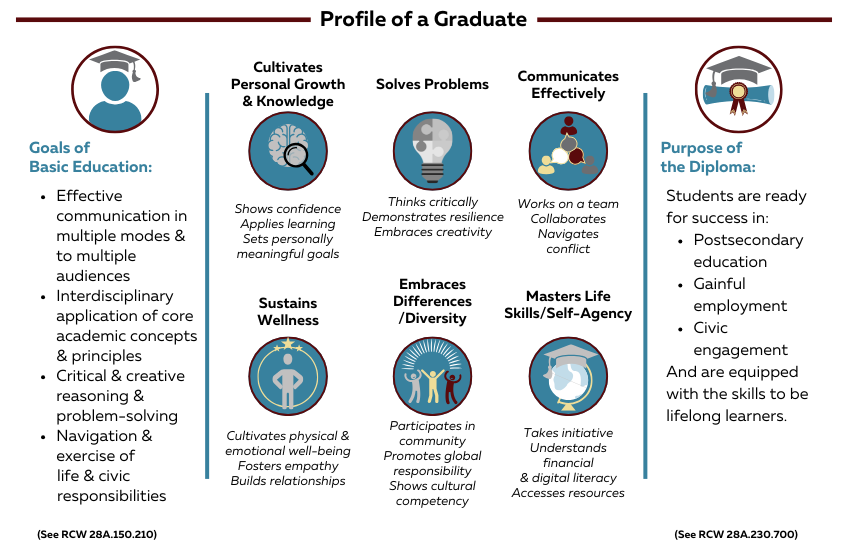In recent history, the concept of “future-ready” PreK-12 education has been closely tied to the development of technical and digital skills—such as coding and digital modeling—to equip students for an increasingly technology-driven world. However, many states and districts have recognized the limitations of this approach. The rapid pace of technological advancement makes it nearly impossible to design technical curricula that remain relevant over time. Skills that are essential today may quickly become obsolete, rendering narrowly focused training ineffective in the long term.
Beyond the challenge of keeping pace with technological change, automation is expected to fundamentally reshape the workforce. While discussions around automation have often centered on entry-level roles, such as call center operations or data entry, the impact of artificial intelligence and machine learning extends far beyond these sectors. Experts anticipate that within the next decade, AI will revolutionize much of the work currently performed by software developers and programmers. Even highly specialized professions, such as cardiology and oncology, are projected to undergo dramatic transformations as technology surpasses human capabilities in accuracy and efficiency.
The World Economic Forum has estimated that nearly 70% of jobs today’s students will eventually hold do not yet exist. Given this uncertainty, educators and curriculum designers cannot realistically anticipate the specific technical skills students will need in their future careers. Without a fixed target, traditional workforce preparation models become insufficient.
Jaime Casap, former Chief Education Evangelist at Google, succinctly captured this challenge: "We are preparing students for jobs that don’t exist, to use technology that hasn’t been invented, to solve problems we don’t even know are problems yet."
In response, states and districts are increasingly shifting their focus toward equipping students with the skills necessary to navigate an unpredictable future. Over the past two decades, competencies such as adaptability, critical thinking, collaboration, and resilience—those same qualities valued by today’s employers—have been recognized as fundamental to K-12 education. Schools are integrating these competencies not only to enhance academic achievement but also to support students’ overall well-being and long-term success. Instruction in these areas strengthens students’ ability to thrive in dynamic environments, both in their personal lives and professional pursuits. But which skills are being featured in these skill-based frameworks most often? According to a 2024 interview from the Harvard Graduate School of Education:
Now, we're not seeing technical skills. What we're seeing are these durable, A.K.A., soft skills. I hate the term "soft skills"... when we use the term durable, they're things that once you learn them, they're durable. You maintain them. So we're seeing skills like critical thinking and problem solving. Those two skills were the most common in the [Portraits of a Graduate] that we reviewed. Social awareness and being an active citizen, communication skills, self-management skills, academic and technical knowledge, collaboration and teamwork, etc. So it's really about durable skills.
—Andrew Tucker, Co-Author of Portraits of a Graduate: Strengthening Career and College Readiness
A comparative analysis of state-level Portraits of a Graduate reveals several key overlapping themes:
- Integration of Human-Centered Skill Development: Most states explicitly include elements of self-awareness, resilience, collaboration, relationship-building, and responsible decision making as core competencies
- Civic + Global Citizenship: States often highlight active citizenship, ethical leadership, and cultural competence to prepare students for diverse, interconnected communities
- Well-Being + Personal Growth: Multiple states emphasize self-management, well-being, and lifelong learning

Nonprofit education advocacy group America Succeeds has delved deep into research on the skills today’s students will need to find success in the future job market, reaching a similar conclusion. The durable skills they detail encompass transferable human-centered competencies that serve individuals in any number of professional fields.

America Succeeds’ Durable Skills Report shows similar results to research on professional skill demand: that, even today, 70% of the skills desired by potential employers are durable rather than technical. Additionally, these skills are sought out nearly four times more often than the most in-demand technical skills and are aligned with the types of management, operations, and engineering positions likely to proliferate over the coming decades.
Durable skills even outrank academic skills in terms of district priorities. A 2022 EdWeek Market Brief asked leaders to rank what they believed to be the areas of highest need in their schools. “Student engagement and motivation” emerged as the top priority, beating out foundational academic skills like reading, writing, and communication competencies. In third place, ranking above math, science, and history, was “student mental health.” These priorities are backed by research demonstrating that comprehensive student support improves engagement and motivation in elementary, middle, and high school students and acts as a preventative mental health measure. Per the EdWeek Market Brief report on 2025-2026 priorities, these remain among the top concerns among administrators.
The good news is that future-ready skill building and academics are not at odds. Thanks to a well-documented meta-analysis and follow-up studies showing that self-management and interpersonal competence support academic performance, it is clear that durable skills education and academics can coexist in schools, with neither detracting from the other. When well integrated across classes and throughout campus culture, durable skills like collaboration and adaptability support success within traditional academics and technical instruction.
Integrating Key Skills Through a Portrait of a Graduate
With a wealth of research to lean on, states and districts are now codifying the need for teaching durable skills into their Portraits of a Graduate. A Portrait of a Graduate—also known by other names, including Vision of a Learner and Graduate Profile—is a framework that outlines the shared vision of a state, district, or school for what skills and knowledge students need to learn as they prepare for life after graduation.
This framework, often co-created with input from educators, policymakers, community stakeholders, and industry leaders, helps shape instructional priorities, align educational practices, and ensure that students graduate prepared for postsecondary education, careers, and civic life. Through surveys, focus groups, and community forums, states and districts gather diverse perspectives on the essential competencies graduates should possess. This collaborative process ensures the vision is relevant, community-driven, and reflective of local economic and social contexts.
Students’ families play a key role in the collaborative process of building a Portrait of a Graduate. According to a 2025 national polling report, families indicated that “social and emotional learning support” was the key to improving student outcomes, ranking it higher than any other type of intervention. Insights like these reveal an ongoing interest in whole-student education.

Based on stakeholder input and research on future workforce demands, districts identify core competencies that extend beyond academic achievement. Once competencies are defined, states and districts embed them within curriculum frameworks, assessment models, and instructional practices. This may involve:
- Curriculum redesign to integrate skills such as problem-solving and communication into core subjects
- Professional development to equip educators with strategies to teach and assess future-ready competencies
- Competency-based learning shifts such as project-based learning, internships, and community partnerships that help students apply skills in real-world contexts
To measure students’ progress in meeting competencies, districts also sometimes shift toward performance-based assessments, including portfolios, capstone projects, and demonstrations of learning. These assessment models emphasize mastery of skills over traditional standardized testing and provide a more holistic measure of student readiness. More traditional classroom skills assessments are sometimes paired with demonstrations of and/or reflections on the Portrait of a Graduate skills students used to complete exams.
Once the vision is developed, tools are created or acquired to teach target skills, and assessments are in place to measure them, states and districts then establish mechanisms to track progress, assess the impact of Portrait of a Graduate implementation, and make data-informed adjustments. This includes:
- Collecting qualitative and quantitative data on student outcomes
- Regularly reviewing and refining the framework based on evolving workforce and societal needs
- Addressing disparities in access to opportunities that develop Portrait competencies and developing strategies for ensuring equity
Consider the following state-level examples:
Vermont’s Portrait of a Graduate
Vermont’s Portrait of a Graduate was developed through a multi-year collaborative process led by the Vermont Agency of Education (AOE). The process was rooted in Vermont’s broader push for personalized, proficiency-based learning, which had been underway for over a decade. The state engaged in regional listening sessions, educator focus groups, and student surveys to ensure the Portrait reflected the needs of diverse learners across urban and rural communities.
To support implementation, the AOE provided guidance documents, professional development resources, and an alignment framework to help districts incorporate the Portrait’s competencies into curriculum design, performance assessments, and student self-reflection tools. The Portrait also aligns with Vermont’s Flexible Pathways Initiative, which allows students to demonstrate proficiency through internships, apprenticeships, and independent projects.

Washington’s Profile of a Graduate
Washington’s Profile of a Graduate emerged from a 2019 legislative directive that required the State Board of Education (SBE) to develop a vision for student success beyond high school. This led to the creation of the Mastery-Based Learning Working Group, which brought together education leaders, legislators, community members, business stakeholders, and students to design the framework.
The development process lasted nearly four years, including:
-
- Multiple rounds of community listening sessions, with special outreach to families of color and students with disabilities
- Surveys and focus groups to gather input from teachers, parents, and industry leaders
- Policy alignment studies to ensure the Profile integrated with existing graduation pathways and workforce development programs
- Multiple rounds of community listening sessions, with special outreach to families of color and students with disabilities
A significant outcome of this process was a statewide effort to align graduation requirements with the Profile. The SBE made 10 recommendations to the legislature, including:
-
- Creating flexible pathways for students to demonstrate mastery of competencies
- Developing career-connected learning options that reflect the Profile’s skills
- Creating flexible pathways for students to demonstrate mastery of competencies

Nevada’s Portrait of a Learner
Nevada’s Portrait of a Learner was developed through a two-year participatory process facilitated by the Nevada Department of Education (NDE). The process was intentionally community-driven, engaging over 1400 stakeholders, including:
- Educators from PreK to higher education
- Students and youth advisory groups
Parents and family advocates - Business and community leaders
- Policymakers and nonprofit organizations
The initiative began with a statewide gathering of over 200 stakeholders, who identified key mindsets and skills for the Portrait. This was followed by virtual town halls, a statewide survey, and working groups that synthesized community input into draft competencies.
To test implementation strategies, NDE piloted the Portrait of a Learner in select districts, conducting case studies to evaluate its impact on school environments. The state also released an implementation roadmap, which includes:
- Professional development for educators on integrating Portrait competencies
- A resource hub with lesson plans and strategies aligned with the Portrait
- Policy recommendations for embedding Portrait competencies into statewide accountability and workforce initiatives
Nevada’s next phase involves scaling up implementation and aligning state education policy to ensure the Portrait becomes a central driver of student success initiatives.

By clearly defining what it means to be future-ready, states like Vermont, Washington, and Nevada have shifted K-12 education from a narrow focus on academic content to a holistic approach that prepares students for life and citizenship. Aligning across state policies, district initiatives, and classroom practices, they’re working to ensure that every student graduates with the skills necessary to thrive.
Measuring Your Portrait of a Graduate
Wayfinder is excited to offer a new feature that brings Portraits of a Graduate to life. This add-on enables educators to seamlessly align their key competencies with Wayfinder’s Core Skills and ensure that skill development is embedded within daily learning, providing automatic activity recommendations based on students’ strengths and growth areas. With Portrait of a Graduate + Wayfinder alignment, schools can easily identify and implement lessons, activities, and resources that directly support their skill development according to their Portrait of a Graduate.
The Portrait of a Graduate feature enables educators to seamlessly align their framework competencies with Wayfinder’s Core Skills and track skill development across the year. By aligning their Portrait of a Graduate with Wayfinder’s Core Skills, schools can easily identify and embed lessons, activities, and resources into daily learning and support skill development.
The feature also enables students to actively document their skill development by uploading evidence of learning, fostering self-reflection and ownership of growth. As students engage with Wayfinder activities and out-of-classroom skill-building, they create a portfolio that visually tracks their progress, making skill-building more tangible and connected to real-world experiences.
Educators and administrators can monitor student growth in real time through an interactive dashboard that provides insights at the district, school, class, and individual student levels. This data-driven approach allows for targeted support and informed decision-making, ensuring that every student is progressing toward the competencies outlined in their Portrait of a Graduate. With Wayfinder, schools have the tools to align, engage, and track student development in a meaningful and actionable way.

To learn more about how states and districts are building out Portraits of a Graduate and the tools Wayfinder offers for facilitating this important work, download our white paper, Portrait of a Future-Ready Graduate: Why Human Skills Matter More Than Ever.





